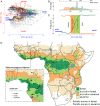Floristic evidence for alternative biome states in tropical Africa
- PMID: 33109722
- PMCID: PMC7668043
- DOI: 10.1073/pnas.2011515117
Floristic evidence for alternative biome states in tropical Africa
Abstract
The idea that tropical forest and savanna are alternative states is crucial to how we manage these biomes and predict their future under global change. Large-scale empirical evidence for alternative stable states is limited, however, and comes mostly from the multimodal distribution of structural aspects of vegetation. These approaches have been criticized, as structure alone cannot separate out wetter savannas from drier forests for example, and there are also technical challenges to mapping vegetation structure in unbiased ways. Here, we develop an alternative approach to delimit the climatic envelope of the two biomes in Africa using tree species lists gathered for a large number of forest and savanna sites distributed across the continent. Our analyses confirm extensive climatic overlap of forest and savanna, supporting the alternative stable states hypothesis for Africa, and this result is corroborated by paleoecological evidence. Further, we find the two biomes to have highly divergent tree species compositions and to represent alternative compositional states. This allowed us to classify tree species as forest vs. savanna specialists, with some generalist species that span both biomes. In conjunction with georeferenced herbarium records, we mapped the forest and savanna distributions across Africa and quantified their environmental limits, which are primarily related to precipitation and seasonality, with a secondary contribution of fire. These results are important for the ongoing efforts to restore African ecosystems, which depend on accurate biome maps to set appropriate targets for the restored states but also provide empirical evidence for broad-scale bistability.
Keywords: alternative stable states; fire; precipitation and seasonality; tree species composition; tropical biomes.
Conflict of interest statement
The authors declare no competing interest.
Figures




References
-
- Ratnam J., et al. , When is a ‘forest’ a savanna, and why does it matter? Glob. Ecol. Biogeogr. 20, 653–660 (2011).
-
- Lehmann C. E., Archibald S. A., Hoffmann W. A., Bond W. J., Deciphering the distribution of the savanna biome. New Phytol. 191, 197–209 (2011). - PubMed
-
- Staver A. C., Archibald S., Levin S. A., The global extent and determinants of savanna and forest as alternative biome states. Science 334, 230–232 (2011). - PubMed
-
- Silva de Miranda P. L., et al. , Using tree species inventories to map biomes and assess their climatic overlaps in lowland tropical South America. Glob. Ecol. Biogeogr. 27, 899–912 (2018).
-
- Hirota M., Holmgren M., Van Nes E. H., Scheffer M., Global resilience of tropical forest and savanna to critical transitions. Science 334, 232–235 (2011). - PubMed
Publication types
MeSH terms
LinkOut - more resources
Full Text Sources

